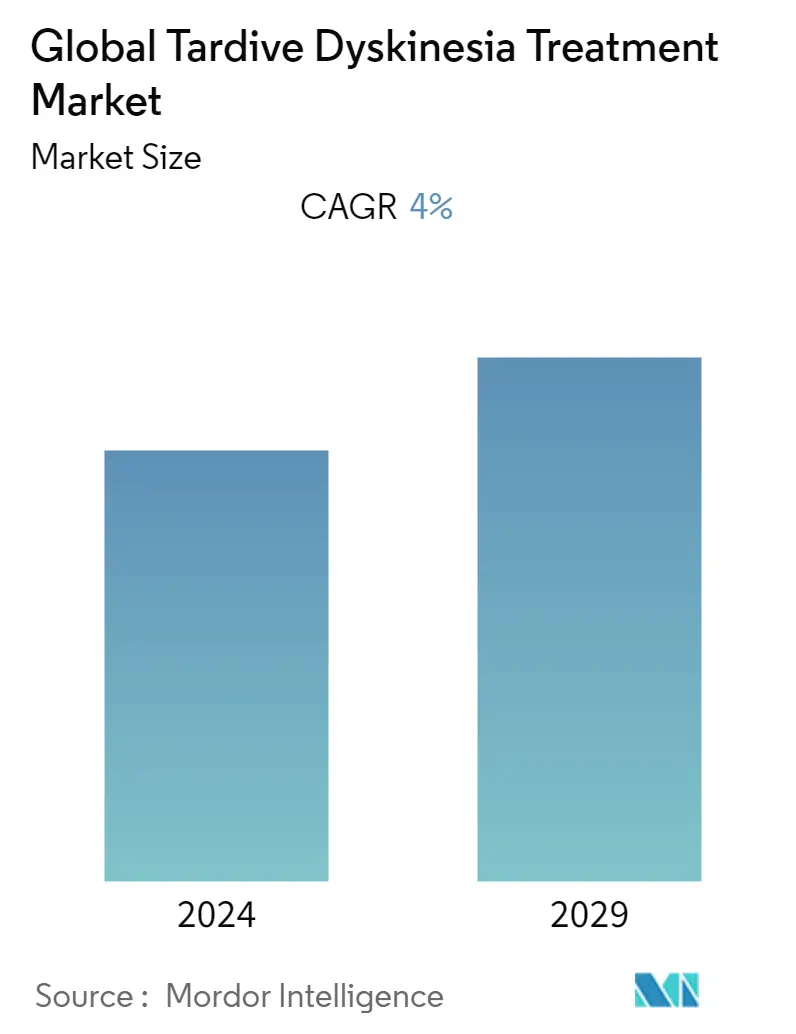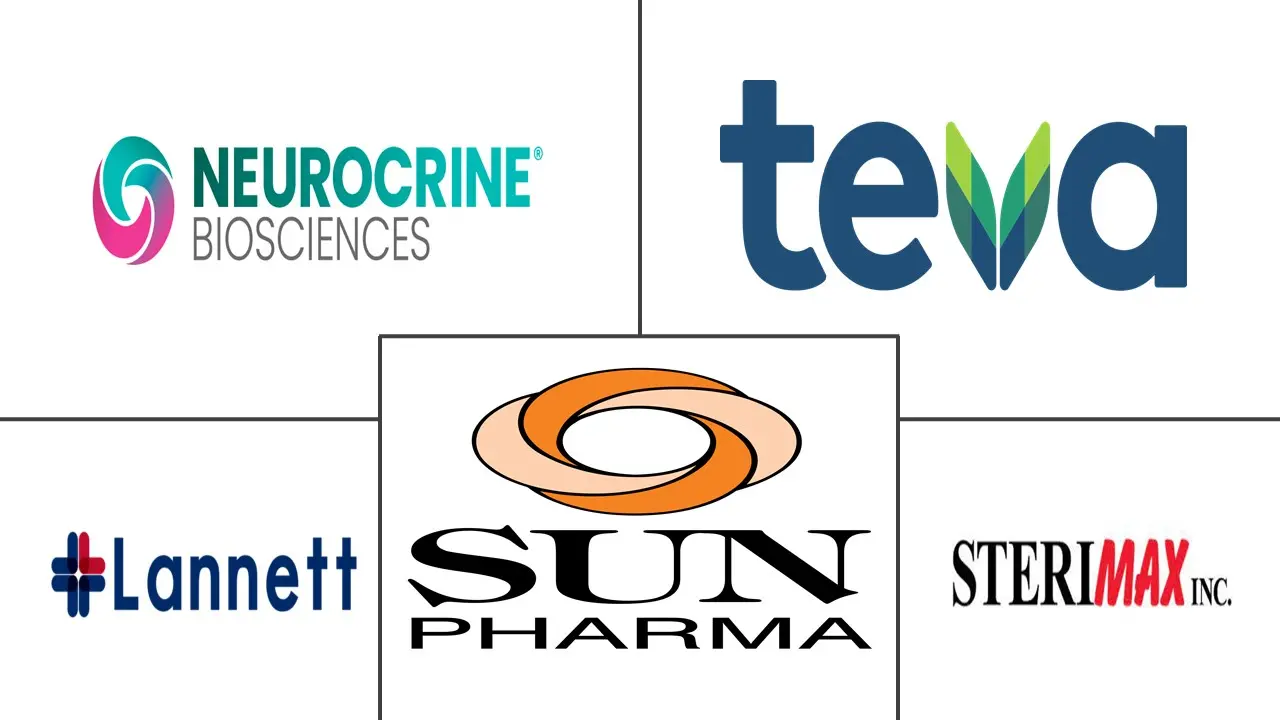Market Size of Global Tardive Dyskinesia Treatment Industry

| Study Period | 2019 - 2029 |
| Base Year For Estimation | 2023 |
| Forecast Data Period | 2024 - 2029 |
| CAGR | 4.00 % |
| Fastest Growing Market | Asia Pacific |
| Largest Market | North America |
Major Players
*Disclaimer: Major Players sorted in no particular order |
Tardive Dyskinesia Treatment Market Analysis
The Tardive Dyskinesia Treatment Market is expected to register a CAGR of 4.2% during the forecast period (2022-2027).
COVID-19 has impacted the patient's access to healthcare facilities as the pandemic has forced the patients to wait for life-saving diagnostics as well as treatment procedures. To slow the spread of the virus, many hospitals have reduced or postponed non-emergency services, like screenings and diagnostic scans. According to the article published in Verywellhealth in October 2021, titled "What to Know About Tardive Dyskinesia and COVID-19," mental health disorders showed an association between the presence of any mental illness and an increased need for hospitalization or dying from COVID-19.
This is attributed to the growing number of Schizophrenia Patients and rising incidences of neurological disorders. With the long-term use of antipsychotic drugs by schizophrenia patients, the chances of patients suffering from tardive dyskinesia are high. Thus high risk is associated with a growing number of antipsychotic drugs leading to promoting the growth of the overall market. For instance, as per the World Health Organization Report in January 2022, Schizophrenia affects about 24 million individuals globally or 0.32%. Adults had a rate of 1 in 222 persons (0.45%).
Furthermore, the global prevalence of Parkinson's disease is estimated to be approximately 6.1 million globally, and the prevalence increases with age, reaching 1% to 3% in the population over 65 years of age, as per the research article 'Monoamine Oxidase-B Inhibitors for the Treatment of Parkinson's Disease: Past, Present, and Future' published in February 2022. In addition, the data updated by World Health Organization (WHO) in October 2021 shows that by 2030, 1 in 6 people in the world will be aged 60 years or over. Thus, rising in the prevalence of Alzheimer's disease is expected to rise in the pool population for tardive dyskinesia, thereby increasing the need for treatment, likely to boost the market.
Additionally, Also, the increasing prevalence of epilepsy in Mexico is also one of the factors driving the growth of the market studied. According to Anales Médicos de la Asociación Médica del Centro Médico ABC, in 2020, Epilepsy has a higher prevalence in developing countries and in Mexico. Prevalence of epilepsy in Mexico was reported with rates of 3.9 to 42.2 per 1,000 inhabitants. Thus increasing the prevalence of neurological diseases tardive dyskinesia population is expected to increase, thereby boosting the market studied.
However, side effects of drugs lack awareness about the disorder, and many undiagnosed cases may restrain the market to a certain extent.
Tardive Dyskinesia Treatment Industry Segmentation
As per the Scope, the Tardive Dyskinesia treatment market deals with the diagnosis of involuntary movement in the jaw, lips, and tongue. The Tardive Dyskinesia Treatment Market is segmented By Disorder (Bradykinesias, Hyperkinesias), Drug Class (Dopamine-Depleting Medications, VMAT2 inhibitors, GABA Receptor agonist medications, Anticholinergic Medications), End User (Hospitals, Clinics, Others), and Geography (North America, Europe, Asia-Pacific, Middle East & Africa, and South America). The market report also covers the estimated market sizes and trends for 17 different countries across major regions globally. The report offers the value (in USD million) for the above segments.
| By Disorder | |
| Bradykinesia | |
| Hyperkinesia |
| By Drug Class | |
| Dopamine-Depleting Medications | |
| VMAT2 Inhibitors | |
| GABA Receptor Agonist Medications | |
| Anticholinergic Medications Trihexyphenidyl |
| By End User | |
| Hospitals | |
| Clinical | |
| Others |
| Geography | ||||||||
| ||||||||
| ||||||||
| ||||||||
| Rest of the World |
Global Tardive Dyskinesia Treatment Market Size Summary
The Tardive Dyskinesia Treatment Market is poised for growth, driven by an increasing prevalence of neurological disorders such as schizophrenia and Parkinson's disease. The long-term use of antipsychotic medications in schizophrenia patients heightens the risk of developing tardive dyskinesia, thereby fueling market expansion. The aging global population, particularly those over 65, is expected to contribute to the rising incidence of these disorders, further boosting the demand for effective treatment options. The market is also influenced by the growing prevalence of epilepsy, especially in regions like Mexico, which adds to the patient pool requiring tardive dyskinesia treatments. Despite these growth drivers, challenges such as drug side effects, lack of awareness, and undiagnosed cases may pose constraints on market development.
North America is anticipated to hold a significant share of the global tardive dyskinesia treatment market, supported by a well-established healthcare infrastructure, high prevalence of schizophrenia, and increasing healthcare expenditure. The region's aging population, prone to neurological conditions, is a key factor in the market's expansion. The market is moderately competitive, with major players like Teva Pharmaceutical Industries Ltd, Neurocrine Biosciences, Inc, and Sun Pharmaceutical Industries Ltd leading the charge. Recent product approvals, such as Neurocrine Biosciences' INGREZZA and Teva Pharmaceuticals' AUSTEDO, highlight ongoing advancements in treatment options. These developments are expected to drive market growth, as they address the needs of targeted patient populations and enhance the stability of psychiatric symptoms in tardive dyskinesia patients.
Global Tardive Dyskinesia Treatment Market Size - Table of Contents
-
1. MARKET DYNAMICS
-
1.1 Market Overview
-
1.2 Market Drivers
-
1.2.1 Increasing Number of Neurological Disorder
-
1.2.2 Growing Antipsychotic Prescriptions
-
1.2.3 Rising Schizophrenia Patients
-
-
1.3 Market Restraints
-
1.3.1 Side Effects of Drugs
-
-
1.4 Porter's Five Forces Analysis
-
1.4.1 Threat of New Entrants
-
1.4.2 Bargaining Power of Buyers/Consumers
-
1.4.3 Bargaining Power of Suppliers
-
1.4.4 Threat of Substitute Products
-
1.4.5 Intensity of Competitive Rivalry
-
-
-
2. MARKET SEGMENTATION (Market Size by Value in USD Million)
-
2.1 By Disorder
-
2.1.1 Bradykinesia
-
2.1.2 Hyperkinesia
-
-
2.2 By Drug Class
-
2.2.1 Dopamine-Depleting Medications
-
2.2.2 VMAT2 Inhibitors
-
2.2.3 GABA Receptor Agonist Medications
-
2.2.4 Anticholinergic Medications Trihexyphenidyl
-
-
2.3 By End User
-
2.3.1 Hospitals
-
2.3.2 Clinical
-
2.3.3 Others
-
-
2.4 Geography
-
2.4.1 North America
-
2.4.1.1 United States
-
2.4.1.2 Canada
-
2.4.1.3 Mexico
-
-
2.4.2 Europe
-
2.4.2.1 Germany
-
2.4.2.2 United Kingdom
-
2.4.2.3 France
-
2.4.2.4 Italy
-
2.4.2.5 Spain
-
2.4.2.6 Rest of Europe
-
-
2.4.3 Asia-Pacific
-
2.4.3.1 China
-
2.4.3.2 Japan
-
2.4.3.3 India
-
2.4.3.4 Australia
-
2.4.3.5 South Korea
-
2.4.3.6 Rest of Asia-Pacific
-
-
2.4.4 Rest of the World
-
-
Global Tardive Dyskinesia Treatment Market Size FAQs
What is the current Global Tardive Dyskinesia Treatment Market size?
The Global Tardive Dyskinesia Treatment Market is projected to register a CAGR of 4% during the forecast period (2024-2029)
Who are the key players in Global Tardive Dyskinesia Treatment Market?
Neurocrine Biosciences, Inc, Teva Pharmaceutical Industries Ltd, Sun Pharmaceutical Industries Ltd, SteriMax Inc. and Lannett Co Inc are the major companies operating in the Global Tardive Dyskinesia Treatment Market.

